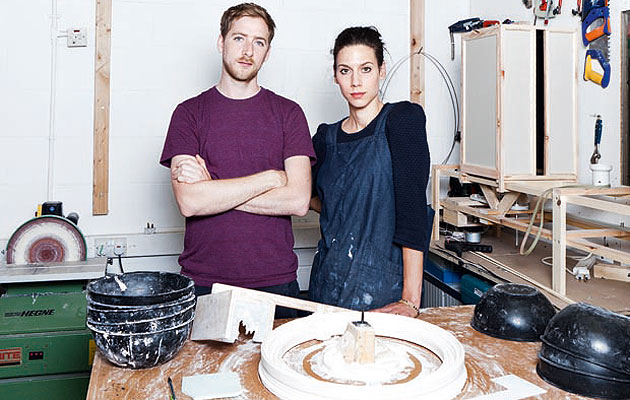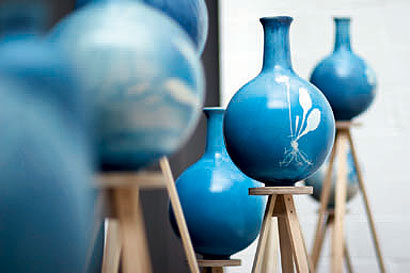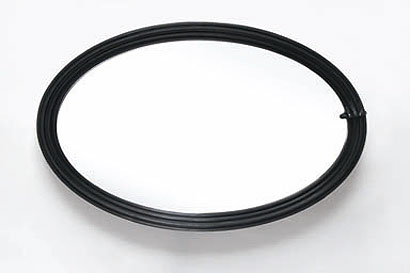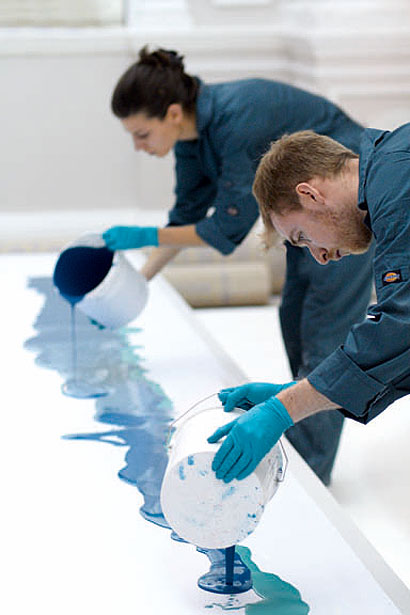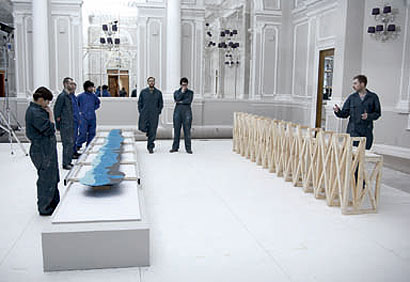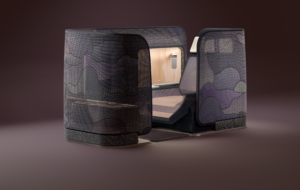|
|
||
|
Every good design studio is driven to make their work unique. For some, that means obsessively refining looks and proportions, or making grand style statements that turn heads at trade fairs. For London-based Studio Glithero, it is about capturing materials in transformation – an art that is as much about film, performance and installation as it is about design. Sarah van Gameren and Tim Simpson set up their studio in 2008, after studying product design together at the Royal College of Art under the direction of Ron Arad. “We wrote a kind of manifesto and it talked about process being equally as important as the finished product,” Simpson says. “But we’re not just interested in describing how things are made – we want to play with it and be a little bit theatrical with it.” The pair’s Blueware vases are on show at the Israel Museum in Jerusalem, as part of the exhibition Curious Minds. These delicately decorated objects employ the cyanotype printing process and echo both the early days of botanical archiving and photographic printing. Weed specimens found near Studio Glithero’s Camden workshop were pressed, dried and arranged on to ceramic vases, which were painted with photosensitive chemicals and exposed to UV light to turn the surface a deep blue. The leaves were then pulled away, leaving their ghostly white impressions. “It’s taken us a few years to really perfect this process,” Simpson says. “We’ve been working on this project for two-and-a-half years, but it has always been tweaked, changed and bettered.”
credit Petr Krejci At last year’s London Design Festival, Studio Glithero presented mirrors from its Bench Mould collection in a group show at Gallery Fumi. The mirror frames are made using tools for creating in-situ architectural plasterwork – the language of architrave, cornice and moulding expressed in a contemporary manner. “We have a plaster company that we talk to and it showed us this trammel mould. It’s a kind of compass that makes an ellipse, working with a few moving sliders like a drawing instrument,” Simpson says, using a film to explain how the tool gradually forms the wet plaster into an oval by a series of sweeping arcs. Each frame is left with a deliberately smudged end, like a maker’s mark. It’s a subtle reminder of the hand that shaped the product.
credit Petr Krejci The Bench Mould collection is an offshoot of the much larger exploration in plaster, Running Mould, which involved a team of nine driving a zinc profile over plaster to form a bench for z33’s Design by Performance in March 2010. It also took a team to create Poured Bar for London’s Corinthia Hotel last year. Simpson, van Gameren and a cast of workers in matching blue overalls poured successive layers of viscous, quick-setting concrete dyed in different shades of blue in 6m-long runs to form a temporary bar in the hotel’s Victorian ballroom. Once the layers had hardened, the resulting slab was flipped and hoisted on to a wooden frame, revealing a collage of blue shapes and a smooth top over which to serve drinks.
credit Petr Krejci Like most of the studio’s projects, the whole spectacle of Poured Bar’s creation was filmed and carefully choreographed. “Film’s the perfect medium to show duration and transformation,” says van Gameren. “We’re sort of envious of the tools that a filmmaker has, where you can deliver a complex plot and timing – things like anticipation and suspense,” Simpson adds. “You can make people feel something in a particular way. You don’t normally get to do that design.” The films function as standalone works of art. The wonder of seeing something being made is captured at a mesmerising pace that fits with the handmade and craftsman-like nature of Studio Glithero’s work. “It’s almost a philosophical thing,” van Gameren says. “A dance, the creation of art or the making of a product … it’s always about the moment it starts to arise – not so much about what is potentially consumable afterwards.” The pair say their projects are becoming increasingly cinematic as their practice evolves. Glithero’s original manifesto was about equating process and product, but their quest to capture moments of creation is slowly superseding the importance of the finished product. It is a difficult path for product designers, who are expected to make things rather than experiences. “We feel a little bit like outsiders in design, but actually it’s the most interesting place for us to be,” van Gameren says. “We’re doing our best to make it kaleidoscopic and complex. To stimulate critique and add depth to design.”
credit Petr Krejci |
Image Andre Penteado
Words Riya Patel |
|
|
||

